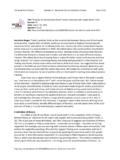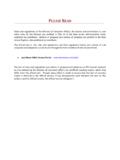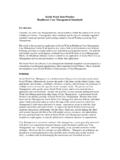Transcription of ARTICLE Narrative in Social Work Catherine Kohler …
1 Qualitative Social WorkCopyright 2005 Sage Publications London, Thousand Oaks, CA and New Delhi, Vol. 4(4): 391 in Social WorkA Critical ReviewCatherine Kohler RiessmanBoston College, USALee QuinneyGlanrhyd Hospital, Wales, UKABSTRACTWe examine how the concept of Narrative has entered socialwork over the past 15 years, with special emphasis onresearch applications. Approaching our task from distinctivestandpoints and locations, the ARTICLE reviews definitions ofnarrative, criteria for good enough Narrative research, andpatterns in Social work journals. Our evaluation uncoveredfew studies, in contrast to the volume of Narrative researchin education, nursing and other practicing professions. Threeexemplars of Narrative inquiry model research completedby Social workers show the knowledge for practice that canbe produced with careful application of Narrative methods,in all their diversity.
2 Drawing on our respective locations andexperiences, we cautiously suggest some reasons for thepaucity of quality research in the USA, and greater represen-tation in WORDS:narrativesocial workresearchstorytellingARTICLE39102 058643 Riessman (to_d) 28/10/05 8:36 am Page 391 Beginning in the late 1960s and continuing at a hectic pace, the idea of narra-tive has penetrated almost every discipline and profession. No longer the soleprovince of literary scholarship, Narrative study now is cross-disciplinary, notfitting within the boundaries of any single scholarly field. The Narrative turn has entered history, anthropology and folklore, psychology, sociolinguistics andcommunication studies, and sociology. The professions, too, have embraced theconcept, along with investigators who study particular professions: law, medicine,nursing, education and occupational Narrative turn is part of alarger turn to language in the Social sciences the springboard for this specialissue.
3 Although Narrative may have some roots in phenomenology (Ricoeur,1991), applications now extend beyond lived experience and worlds behind the author. A central area of Narrative study is human interaction in relation-ships the daily stuff of Social purpose is to examine the status of Narrative in Social work , withparticular attention to research applications in journals, and to critically inter-rogate the results of the review. There is Narrative scholarship by Social workersin books and book chapters (cf. Hall, 1997; Laird, 1993; Riessman, 1994; Shawand Gould, 2001), but academic journals remain the primary outlet for publi-cation. How has Narrative shaped Social work scholarship there? More specifi-cally, has there been systematic application of Narrative methods (howeverdiverse) in research?
4 Social work is based on talk and interaction, and weexpected to find many investigators taking up Narrative approaches to studyinteractions with clients, and talk about clients with other professionals. We weresurprised by the small corpus of systematic research, but pleased to uncoverseveral caveat about our mode of presentation first, before turning to com-plexities of definition, evaluation of the literature, and speculation about possiblereasons for the paucity of Narrative research in Social work . The ARTICLE includesseveral voices because we occupy distinct Social locations, bring different per-spectives and experiences to the evaluation, and our respective roles in theproject were distinctive. Riessman is a senior Narrative researcher, NorthAmerican and a former faculty member of several US schools of Social work ,far removed from practice.
5 She took responsibility for analysis of the literatureand for crafting the ARTICLE . Quinney is a British Social work practitioner andpostgraduate research student, beginning a career that has included groundedtheory methods and will include Narrative . He completed a large part of thelibrary research, wrote impressions, and added the voice of a practitioner to ourfinal draft. We approached the topic of Narrative from particular standpoints, asall investigators do, but these generated difficulties in writing (we have nevermet face-to-face). Readers will notice a shift in pronouns and, at points in ourtext, one of our names identifies a particular set of ideas. Although awkward,the device preserves our respective voices a hallmark of Narrative and allows392 Qualitative Social work 4(3)02 058643 Riessman (to_d) 28/10/05 8:36 am Page 392us to present a story of the research endeavour.
6 As in all stories, multiple voicesand identities come into IS Narrative ?The term Narrative carries many meanings and is used in a variety of ways bydifferent disciplines, often synonymously with story . We caution readers notto expect a simple clear definition of Narrative here that can cover all appli-cations, but we will review some definitions in use, and identify essential ingre-dients. Narrative inquiry in the human sciences is a 20th-century development;the field has realist , postmodern and constructionist strands, and scholarsdisagree on origins and precise definitions (cf. Chase, 2005; Langellier, 2001;Riessman, 1993, forthcoming).Riessman (1997) has written elsewhere about the tyranny of narrativeand her concerns continue: the term currently has a level of popularity fewwould have predicted when some of us began working with stories thatdeveloped in research interviews and medical consultations 20 years ago.
7 To putit simply, the term has come to mean anything and everything; when someonespeaks or writes spontaneously, the outcome is now called Narrative by newsanchors and qualitative investigators alike. It is not appropriate to policelanguage, but specificity has been lost with popularization. All talk and text arenot Narrative . Developing a detailed plot, character, and the complexities of asetting are not needed in many communicative exchanges. Storytelling is onlyone genre, which humans employ to accomplish certain effects. Other forms ofdiscourse besides Narrative include chronicles, reports, arguments and questionand answer exchanges, to name a few (Riessman, 1993, forthcoming).In everyday use, however, Narrative has become little more than metaphor everyone has her story a rising trend linked to the use of the term in popularculture: telling one s story on television, or at a self-help group meeting.
8 Missingfor the Narrative scholar is analytic attention to how the facts got assembled thatway. For whom was thisstory constructed, how was it made, and for whatpurpose? What cultural resources does it draw on take for granted? What doesit accomplish? Are there gaps and inconsistencies that might suggest alternativecounter-narratives? In popular usage, a story seems to speak for itself, not requir-ing interpretation an indefensible position for serious personal stories are certainly prevalent in contemporary life, Narrative has a robust life beyond the self . Narrative has energized an arrayof fields in the Social sciences: studies of Social movements, organizations,politics and other macro-level processes. As individuals construct stories ofexperience, so too do nations, governments, and organizations construct pre-ferred narratives about themselves.
9 Perhaps a push toward Narrative comes fromcontemporary preoccupations with identity. No longer viewed as given andRiessman & QuinneyNarrative in Social work 39302 058643 Riessman (to_d) 28/10/05 8:36 am Page 393 natural , individuals must now construct who they are and how they want tobe known, just as groups, organizations, and nations do. In postmodern times,identities can be assembled and disassembled, accepted and contested (Holsteinand Gubrium, 2000).Among scholars working with personal accounts for research purposes,there is a range of definitions of Narrative , often linked to discipline. In socialhistory and anthropology, Narrative can refer to an entire life story, woven fromthreads of interviews, observations, and documents. Barbara Myerhoff s ethnog-raphy of Aliyah Senior Citizens in Venice, California is a classic example.
10 Fromtaped conversations of Living History classes, combined with observations ofthe life of the Center and poems and stories written by members, she composedcompelling narratives of the lives of elderly Jews living out their days and per-forming their lives (Myerhoff, 1978; Myerhoff et al., 1992).At the other end of the continuum lies the very restrictive definition ofsociolinguistics. Here a story refers to a discrete unit of discourse: an answer toa single question, topically-centered and temporally-organized. The classicexample is Labov (1982), who analyzed bounded tape-recorded answers to aquestion about a violent in the middle on a continuum of definitions is work in psy-chology and sociology. Here, personal Narrative encompasses long sections oftalk extended accounts of lives in context that develop over the course ofsingle or multiple interviews.





